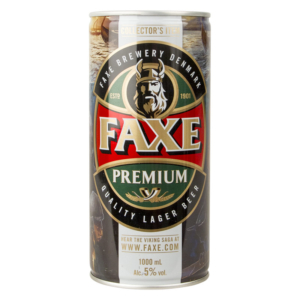When the mandatory deposit was introduced in 2003, sales of beverage cans plummeted: instead of the previous 7.5 billion, only around 300 million were sold in the following year. In the meantime, however, the beverage can is clearly on the rise again – which, in addition to the popular energy drink, is also due to beer. Demand has been soaring since 2013. We are experiencing a comeback of canned beer!
Beverage can is the recycling champion

Envases also produces 1-liter beer cans – mainly for the Danish market.
One reason for this is that a simplified return system has long since been established in the retail trade. Moreover, the environmental properties of the beverage can have improved significantly as a result of the reduced material usage. When it was launched in 1935, a 0.33 liter aluminum can weighed 100 grams. Today it weighs only around 12 grams. Its walls are thinner than a human hair.
Although still not without controversy among environmentalists, the beverage can is now a recycling champion: In Germany, more beverage cans are handed in at deposit machines than ever before. By contrast, according to a new study by the Association for Packaging Market Research “GVM Gesellschaft für Verpackungsmarktforschung mbH”, the share of beverage cans in the waste carelessly thrown into the environment fell to 0.03 percent in 2019. At the same time, the recycling rate for aluminum beverage cans in Germany rose to 99.3 percent, and for steel cans to 99.7 percent. This is the highest recycling value for a beverage container in the world. For the Beverage Can Forum, this is “a prime example of a functioning closed-loop product,” and the beverage can is consequently “the recycling champion among beverage packaging.”
Light, handy, unbreakable: young people in particular love beverage cans

Bild: The advantage of the beer can lies in the fact that it can be printed on all sides, making it ideal for special marketing campaigns – such as Krombacher’s for the Wacken Open Air. Photo: Krombacher
Manufacturers and retailers appreciate the disposable container because they benefit from more cost-effective handling compared to the glass bottle. This is because beverage cans can be stacked easily and stored in a space-saving manner. The beverage can also scores in terms of marketing. They can be printed on all sides and therefore have more surface area available for brand information and design than labeled containers. This makes the beer can ideal for special editions and special marketing campaigns. Last summer, for example, Krombacher launched, among other things, limited-edition promotional cans in the Wacken Open Air festival design or – on the occasion of the very successful Euro League season – an Eintracht Frankfurt can. In 2018, the company commissioned its own can filling line on the brewery premises.

In German stores, the 1-liter beer can is sometimes found in combination with special marketing promotions.
From Pils to Craft Beer: Comeback of Canned Beer
Many craft beer brewers have also discovered the beer can. While having long been the first choice among American craft beer drinkers, the can initially had a hard time in the scene in Germany. But here, too, a change is underway: more and more craft beer is being offered exclusively in cans. In 2019, a total of around 3.9 billion beverage cans were sold in Germany. Well over 40 percent of these are beer cans. The most common can sizes in Europe are 0.33 and 0.5 liters, and less frequently one liter. The latter is most common in Denmark, where it is also produced by Envases – known in this country for its five-liter party kegs from Öhringen. For special marketing campaigns, the 1-liter beer can is occasionally also found in German stores.
Even though the refillable glass bottle is the undisputed number one container type, the beer can is gaining more and more ground. With eight percent of beer and 17 percent of mixed beer beverages, disposable cans now account for the second largest share of beer sales. The trend is rising sharply – which means that the comeback of canned beer is in full swing!
Cover picture: Wacken 2022_Qolabo_Krombacher_© Ben Knabe



